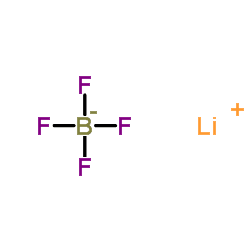Formula LiBF4 Melting point 296.5 °C | Molar mass 93.746 g/mol Density 852 kg/m³ | |
 | ||
Related compounds Appearance White/grey crystalline solid | ||
Lithium tetrafluoroborate is an inorganic compound with the formula LiBF4. It is a white crystalline powder. It has been extensively tested for use in commercial secondary batteries, an application that exploits its high solubility in nonpolar solvents.
Contents
Applications
Although BF4− has high ionic mobility, solutions of its Li+ salt are less conductive than other less associated salts. As an electrolyte in Lithium-ion batteries, LiBF4 offers some advantages relative to the more common LiPF6. It exhibits greater thermal stability and moisture tolerance. For example, LiBF4 can tolerate a moisture content up to 620 ppm at room temperature whereas LiPF6 readily hydrolyzes into toxic POF3 and HF gases, often destroying the battery's electrode materials. Disadvantages of the electrolyte include a relatively low conductivity and difficulties forming a stable solid electrolyte interface with graphite electrodes.
Thermal stability
Because LiBF4 and other alkali-metal salts thermally decompose to evolve boron trifluoride, the salt is commonly used as a convenient source of the chemical at the laboratory scale:
LiBF4 → LiF + BF3Production
LiBF4 is a byproduct in the industrial synthesis of diborane:
8 BF3 + 6 LiH → B2H6 + 6 LiBF4LiBF4 can also be synthesized from LiF and BF3 in an appropriate solvent that is resistant to fluorination by BF3 (e.g. HF, BrF3, or liquified SO2):
LiF + BF3 → LiBF4